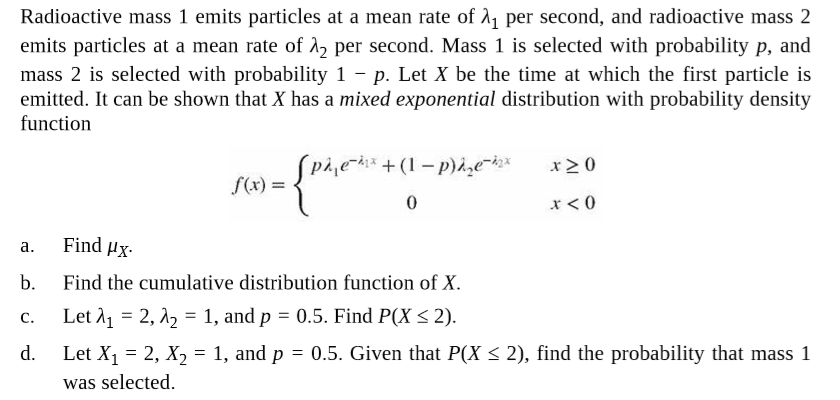Radioactive mass 1 emits particles at a mean rate of 1, per second, and radioactive mass 2 emits particles at a mean rate of 2 per second. Mass 1 is selected with probability p, and mass 2 is selected with probability 1 - p. Let X be the time at which the first particle is emitted. It can be shown that X has a mixed exponential distribution with probability density function SPhieh+(1- p)Àze* S(x) = x > 0 a. Find Hx- b. Find the cumulative distribution function of X. C. Let 11 = 2, 12 = 1, and p = 0.5. Find P(X < 2). d. Let X, = 2, X, = 1, and p = 0.5. Given that P(X < 2), find the probability that mass 1 was selected.
Radioactive mass 1 emits particles at a mean rate of 1, per second, and radioactive mass 2 emits particles at a mean rate of 2 per second. Mass 1 is selected with probability p, and mass 2 is selected with probability 1 - p. Let X be the time at which the first particle is emitted. It can be shown that X has a mixed exponential distribution with probability density function SPhieh+(1- p)Àze* S(x) = x > 0 a. Find Hx- b. Find the cumulative distribution function of X. C. Let 11 = 2, 12 = 1, and p = 0.5. Find P(X < 2). d. Let X, = 2, X, = 1, and p = 0.5. Given that P(X < 2), find the probability that mass 1 was selected.
MATLAB: An Introduction with Applications
6th Edition
ISBN:9781119256830
Author:Amos Gilat
Publisher:Amos Gilat
Chapter1: Starting With Matlab
Section: Chapter Questions
Problem 1P
Related questions
Question

Transcribed Image Text:Radioactive mass 1 emits particles at a mean rate of 1, per second, and radioactive mass 2
emits particles at a mean rate of 2 per second. Mass 1 is selected with probability p, and
mass 2 is selected with probability 1 - p. Let X be the time at which the first particle is
emitted. It can be shown that X has a mixed exponential distribution with probability density
function
SPhieh+(1- p)Àze*
S(x) =
x > 0
a.
Find Hx-
b.
Find the cumulative distribution function of X.
C.
Let 11 = 2, 12 = 1, and p = 0.5. Find P(X < 2).
d.
Let X, = 2, X, = 1, and p = 0.5. Given that P(X < 2), find the probability that mass 1
was selected.
Expert Solution
This question has been solved!
Explore an expertly crafted, step-by-step solution for a thorough understanding of key concepts.
This is a popular solution!
Trending now
This is a popular solution!
Step by step
Solved in 4 steps with 4 images

Recommended textbooks for you

MATLAB: An Introduction with Applications
Statistics
ISBN:
9781119256830
Author:
Amos Gilat
Publisher:
John Wiley & Sons Inc

Probability and Statistics for Engineering and th…
Statistics
ISBN:
9781305251809
Author:
Jay L. Devore
Publisher:
Cengage Learning

Statistics for The Behavioral Sciences (MindTap C…
Statistics
ISBN:
9781305504912
Author:
Frederick J Gravetter, Larry B. Wallnau
Publisher:
Cengage Learning

MATLAB: An Introduction with Applications
Statistics
ISBN:
9781119256830
Author:
Amos Gilat
Publisher:
John Wiley & Sons Inc

Probability and Statistics for Engineering and th…
Statistics
ISBN:
9781305251809
Author:
Jay L. Devore
Publisher:
Cengage Learning

Statistics for The Behavioral Sciences (MindTap C…
Statistics
ISBN:
9781305504912
Author:
Frederick J Gravetter, Larry B. Wallnau
Publisher:
Cengage Learning

Elementary Statistics: Picturing the World (7th E…
Statistics
ISBN:
9780134683416
Author:
Ron Larson, Betsy Farber
Publisher:
PEARSON

The Basic Practice of Statistics
Statistics
ISBN:
9781319042578
Author:
David S. Moore, William I. Notz, Michael A. Fligner
Publisher:
W. H. Freeman

Introduction to the Practice of Statistics
Statistics
ISBN:
9781319013387
Author:
David S. Moore, George P. McCabe, Bruce A. Craig
Publisher:
W. H. Freeman